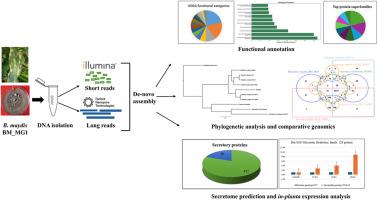Genome sequence of Bipolaris maydis inciting maydis leaf blight provides insights into genome architecture and putative effector repertoire
IF 3.3
3区 农林科学
Q2 PLANT SCIENCES
引用次数: 0
Abstract
Maydis leaf blight (MLB) incited by Bipolaris maydis is one of the primary diseases of maize causing significant yield losses. For gaining a better insight into the genome organization and the molecular basis of pathogenesis related traits, the genome of B. maydis isolate BM_MG1 collected from maize fields in India, was sequenced using both the Illumina and Oxford Nanopore platforms. The final assembly yielded a genome size of 36.05 Mb with a GC content of 49.21 %. A total of 56 contigs were obtained with a N50 of 2,100,550 bp. Gene prediction identified 9013 genes, with 8866 significantly annotated through BLASTX analysis using an E-value cutoff of 10−3. Amongst the transposable elements, the Gypsy elements were found to be highest in number. A total of 7534 simple sequence repeats were identified in the sequenced genome, with mononucleotide SSRs (3,434) being the most abundant type. Out of 510 secretory proteins identified, 136 were predicted as candidate secreted effector proteins (CSEPs), mainly including pectin lyase fold/virulence factors, alpha/beta hydrolase fold, and Concanavalin A-like lectin/glucanase domain superfamily proteins. The expression of glycoside hydrolase family 128 protein of B. maydis was found to be upregulated in the susceptible genotype of maize in our study, indicating its role in pathogenesis. The genomic and secretome information of B. maydis will provide valuable insights in understanding the intricate pathogenesis mechanisms and the arsenal of molecules deployed by the pathogen for effective colonization. In future, this information can be exploited for the development of improved management strategies.

引发马叶枯病的马叶枯病双北极星的基因组序列为基因组结构和假定的效应库提供了见解
Maydis leaf blight (MLB)是玉米主要病害之一,是玉米产量损失最大的病害之一。为了更好地了解maydis的基因组结构和发病相关性状的分子基础,利用Illumina和Oxford Nanopore平台对从印度玉米田收集的maydis分离株BM_MG1进行了基因组测序。最终组装的基因组大小为36.05 Mb, GC含量为49.21%。共获得56个contigs, N50为2,100,550 bp。基因预测鉴定出9013个基因,其中8866个基因通过BLASTX分析得到显著注释,e值截止值为10−3。在转座元素中,吉普赛元素的数量最多。在测序基因组中共鉴定出7534个简单重复序列,其中单核苷酸SSRs(3434)是最丰富的类型。在鉴定的510种分泌蛋白中,136种被预测为候选分泌效应蛋白(csep),主要包括果胶裂解酶折叠/毒力因子、α / β水解酶折叠和豆豆蛋白a样凝集素/葡聚糖酶结构域超家族蛋白。本研究在玉米易感基因型中发现麦叶蚜糖苷水解酶家族128蛋白表达上调,提示其在发病机制中的作用。maydis的基因组和分泌组信息将为了解复杂的发病机制和病原体有效定植的分子库提供有价值的见解。今后,可以利用这些资料制定改进的管理战略。
本文章由计算机程序翻译,如有差异,请以英文原文为准。
求助全文
约1分钟内获得全文
求助全文
来源期刊
CiteScore
4.30
自引率
7.40%
发文量
130
审稿时长
38 days
期刊介绍:
Physiological and Molecular Plant Pathology provides an International forum for original research papers, reviews, and commentaries on all aspects of the molecular biology, biochemistry, physiology, histology and cytology, genetics and evolution of plant-microbe interactions.
Papers on all kinds of infective pathogen, including viruses, prokaryotes, fungi, and nematodes, as well as mutualistic organisms such as Rhizobium and mycorrhyzal fungi, are acceptable as long as they have a bearing on the interaction between pathogen and plant.

 求助内容:
求助内容: 应助结果提醒方式:
应助结果提醒方式:


